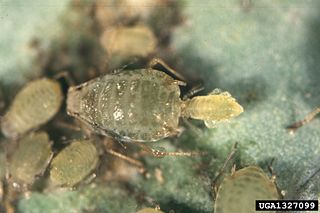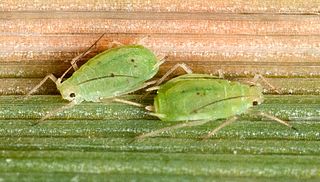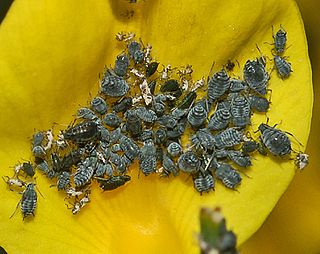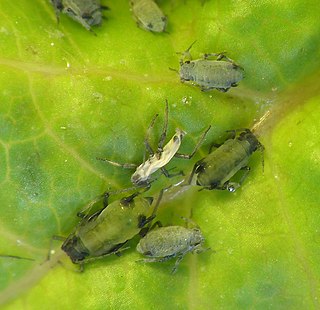Related Research Articles

The Russian wheat aphid is an aphid that can cause significant losses in cereal crops. The species was introduced to the United States in 1986 and is considered an invasive species there. This aphid is pale green and up to 2 mm long. Cornicles are very short, rounded, and appear to be lacking. There is an appendage above the cauda giving the aphid the appearance of having two tails. The saliva of this aphid is toxic to the plant and causes whitish striping on cereal leaves. Feeding by this aphid will also cause the flag leaf to turn white and curl around the head causing incomplete head emergence. Host plants: cereal grain crops including wheat and barley and to a lesser extent, wild grasses such as wheatgrasses, brome-grasses, ryegrasses and anything in the grass family.

Rhopalosiphum is a genus of aphid of the family Aphididae that includes 16 species worldwide. Apart from sucking the phloem of host plants and thereby being treated in agriculture as pests, some species are vectors for viral pathogens.

The soybean aphid is an insect pest of soybean that is exotic to North America. The soybean aphid is native to Asia. It has been described as a common pest of soybeans in China and as an occasional pest of soybeans in Indonesia, Japan, Korea, Malaysia, the Philippines, and Thailand. The soybean aphid was first documented in North America in Wisconsin in July 2000. Ragsdale et al. (2004) noted that the soybean aphid probably arrived in North America earlier than 2000, but remained undetected for a period of time. Venette and Ragsdale (2004) suggested that Japan probably served as the point of origin for the soybean aphid's North American invasion. By 2003, the soybean aphid had been documented in Delaware, Georgia, Illinois, Indiana, Iowa, Kansas, Kentucky, Michigan, Minnesota, Mississippi, Missouri, Nebraska, New York, North Dakota, Ohio, Pennsylvania, South Dakota, Virginia, West Virginia, and Wisconsin. Together, these states accounted for 89% of the 63,600,000 acres (257,000 km2) of soybean planted in the United States in 2007.

Rhopalosiphum maidis, common names corn leaf aphid and corn aphid, is an insect, and a pest of maize and other crops. It has a nearly worldwide distribution and is typically found in agricultural fields, grasslands, and forest-grassland zones. Among aphids that feed on maize, it is the most commonly encountered and most economically damaging, particularly in tropical and warmer temperate areas. In addition to maize, R. maidis damages rice, sorghum, and other cultivated and wild monocots.

Phylloxeridae is a small family of plant-parasitic hemipterans closely related to aphids with only 75 described species. This group comprises two subfamilies and 11 genera with one that is fossil. The genus type is Phylloxera. The Phylloxeridae species are usually called Phylloxerans or Phylloxerids.

Lachninae is a subfamily of the family Aphididae, containing some of the largest aphids, and they are sometimes referred to as "giant aphids". Members of this subfamily typically have greatly reduced cornicles compared to other aphids, and the group has sometimes been classified as a separate family.
Aphis spiraecola is a species of aphid described in 1914 by Edith Marion Patch. Its common names include green citrus aphid, Spirea aphid, and apple aphid. It is distributed worldwide, and is most abundant in the United States. It has a diploid chromosome number of 2n=8.

Lipaphis is a genus of aphids of the family Aphididae.
The Chinese Akkaia,, is an aphid in the superfamily Aphidoidea in the order Hemiptera. It is a true bug and sucks sap from plants.

The greenbug, or wheat aphid, is an aphid in the superfamily Aphidoidea in the order Hemiptera. It is a true bug and feeds on the leaves of Gramineae (grass) family members.

Aphis genistae is an aphid of the family Aphididae.

Lachnus is a genus of aphids and the name-bearing type genus of the subfamily Lachninae. It consists of about 20 species.

Hyadaphis is a genus of aphids in the family Aphididae. There are about 19 described species in Hyadaphis.

Schizaphis is a genus of aphid in the family Aphididae superfamily Aphidoidea, order Hemiptera. Its original distribution is the Palaearctic, but some species have been introduced to other parts of the world.There are about 40 recognized Schizaphis species worldwide.

Periphyllus is a genus of maple aphids in the family Aphididae. There are more than 40 described species in Periphyllus.

Sitobion is a genus of aphids in the family Aphididae. There are more than 80 described species in Sitobion.

Capitophorus is a genus of aphids in the family Aphididae. There are more than 30 described species in Capitophorus.
Neophyllaphis is a genus of aphids in the family Aphididae. There are about 18 described species in Neophyllaphis.

Hyperomyzus is a genus of aphids in the family Aphididae. There are more than 20 described species in Hyperomyzus.

Hormaphis is a genus of witch hazel and palm aphids in the family Aphididae. There are at least three described species in Hormaphis, found mainly in eastern North America.
References
- Eastop, V. F. (1953). "A study of the Tramini (Homoptera—Aphididae)". Transactions of the Royal Entomological Society of London. 104 (10): 385–413. doi:10.1111/j.1365-2311.1953.tb01243.x.
- Narzikulov, M. N. (1973). "Palearctic aphids of the genus Trama Heyden, 1837 (Homoptera, Aphidinea, Lachnidae)". Entomological Review. 52: 72–77.
- Blackman, Roger L.; Spence, Jennifer M. & Normark, Benjamin B. (2000). "High diversity of structurally heterozygous karyotypes and rDNA arrays in parthenogenetic aphids of the genus Trama (Aphididae: Lachninae)". Heredity. 84 (2): 254–260. doi:10.1046/j.1365-2540.2000.00667.x.
- Blackman, Roger L.; De Boise, Emma & Czylok, Andrzej (2001). "Occurrence of sexual morphs in Trama troglodytes von Heyden, 1837 (Hemiptera, Aphididae)". Journal of Natural History. 35 (5): 779–785. doi:10.1080/00222930152023108.